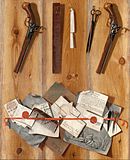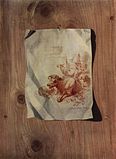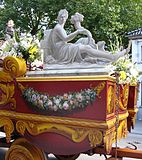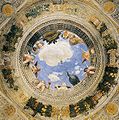
Trompe-l'œil
Trompe-l'œil (French for 'deceive the eye'; /trɒmpˈlɔɪ/ tromp-LOY; French: [tʁɔ̃p lœj] ⓘ) is an artistic term for the highly realistic optical illusion of three-dimensional space and objects on a two-dimensional surface. Trompe l'œil, which is most often associated with painting, tricks the viewer into perceiving painted objects or spaces as real. Forced perspective is a related illusion in architecture.
This article is about the artistic term. For the album by Malajube, see Trompe-l'oeil (album). For the Westworld episode, see Trompe L'Oeil (Westworld). For the mural by Maria Bettina Cogliatti, see Trompe-l'œil (mural).Perspective[edit]
A fascination with perspective drawing arose during the Renaissance. But also Giotto began using perspective at the end of the 13th century with the cycle of Assisi in Saint Francis stories. Many Italian painters of the late Quattrocento, such as Andrea Mantegna (1431–1506) and Melozzo da Forlì (1438–1494), began painting illusionistic ceiling paintings, generally in fresco, that employed perspective and techniques such as foreshortening to create the impression of greater space for the viewer below. This type of trompe l'oeil illusionism as specifically applied to ceiling paintings is known as di sotto in sù, meaning "from below, upward" in Italian. The elements above the viewer are rendered as if viewed from true vanishing point perspective. Well-known examples are the Camera degli Sposi in Mantua and Antonio da Correggio's (1489–1534) Assumption of the Virgin in the Parma Cathedral.
Similarly, Vittorio Carpaccio (1460–1525) and Jacopo de' Barbari (c. 1440 – before 1516) added small trompe l'œil features to their paintings, playfully exploring the boundary between image and reality. For example, a painted fly might appear to be sitting on the painting's frame, or a curtain might appear to partly conceal the painting, a piece of paper might appear to be attached to a board, or a person might appear to be climbing out of the painting altogether—all in reference to the contest of Zeuxis and Parrhasius.
Examples of trompe-l'œil paintings
Still-Life with Partridge and Gauntlets by Jacopo de' Barbari, 1504. The first still-life trompe l'œil since antiquity
Trompe-l'oeil, Jean-François de Le Motte, 1680-1700
Trompe l´oeil 1737 by Carl Hofverberg
Trompe l'oeil of a wooden panelling with a painted canvas and print of a landscape capriccio, Jacobus Plasschaert, 1650s
Printed Pages. Trompe l'œil by Nicolaas de Wit, 1740
Char de la Ville (photographed 2006) - the "sculpture" is a flat cutout
Oculus on the ceiling of the Spouses Chamber, castle of San Giorgio in Mantua, Italy, by Andrea Mantegna
A trompe-l'œil of a pigeon on a window sill, façade mural, rue Emile Lepeu in the 11th arrondissement of Paris, France
Architectural wall and ceiling trompe-l'œil, Entrance to the library of Chateau Thal, by Rainer Maria Latzke
Conceptual trompe-l'œil mural at California State University, Chico titled "Academe", featuring Doric columns and crumbling walls, by John Pugh
19th-century marble bust with apparently transparent veil, Bankfield Museum, Halifax, West Yorkshire.
The same bust seen in profile. The effect is consistent from all angles and from close up.
A modern trompe-l'œil mosaic fountain at Brighton, in the form of a carpet thrown over marble steps.
Detail of the forced perspective stage scenery of the Teatro Olimpico, as viewed through the porta reggia of the scaenae frons, Vicenza, northern Italy
The Painted Hall at the Old Royal Naval College in Greenwich, London, England, designed by Sir Christopher Wren and Nicholas Hawksmoor. The paintings by Sir James Thornhill comprise architectural trompes l'œil; for instance, the Corinthian columns look fluted whilst the far wall depicts pilasters and an entablature. In practice none of these elements exist in the third dimension
(1952)
Singin' in the Rain
(1971)
Willy Wonka & the Chocolate Factory
(1989)
Indiana Jones and the Last Crusade
(1990)
Where the Heart Is
(2001)
Millennium Actress
(2004)
Eternal Sunshine of the Spotless Mind
(2005)
Bewitched
(2016)
Westworld (Season 1, Episode 7)
- enhancement of 2-dimensional graphics by limited application of some 3D effects to them
2.5D
normal mapping and parallax mapping - graphical techniques used to add fake details that enhance 2D representations of 3D objects (in the context of that branch of computer graphics that aims to give a realistic 3D view on the screen)
Bump mapping
Camouflage
Marbling
Faux painting
Photorealism
Anamorphosis
List of art techniques
Wade, Nicholas J; Hughes, Patrick (September 1999). "Fooling the Eyes: Trompe L'Oeil and Reverse Perspective". Perception. 28 (9): 1115–1119. :10.1068/p281115. PMID 10694961. S2CID 690634.
doi
Kaufmann, Thomas DaCosta; Kaufmann, Virginia Roehrig (1991). "The Sanctification of Nature: Observations on the Origins of Trompe l'oeil in Netherlandish Book Painting of the Fifteenth and Sixteenth Centuries". The J. Paul Getty Museum Journal. 19: 43–64. 4166611.
JSTOR
Nanay, Bence (March 2015). "Trompe l'oeil and the Dorsal/Ventral Account of Picture Perception". Review of Philosophy and Psychology. 6 (1): 181–197. :10.1007/s13164-014-0219-y. hdl:10067/1232140151162165141. S2CID 256075115.
doi
National Gallery of Art exhibition on Trompe-l'œil paintings
Deceptions and Illusions
essay by Lois Parkinson Zamora comparing trompe-l'œil to the literature of Borges
Trompe l'œil Tricks: Borges' Baroque Illusionism
Fresco Blog
Custom trompe l'œil Paintings
Archived 2011-12-12 at the Wayback Machine, More than 10 000 pictures and 1200 Outdoor murals of France and Europe
murals.trompe-l-oeil.info
Avenue George V. Text and photography by Catherine-Alice Palagret










































